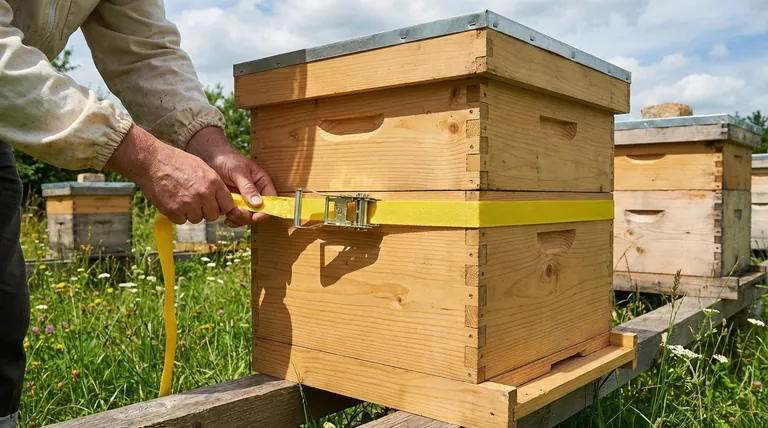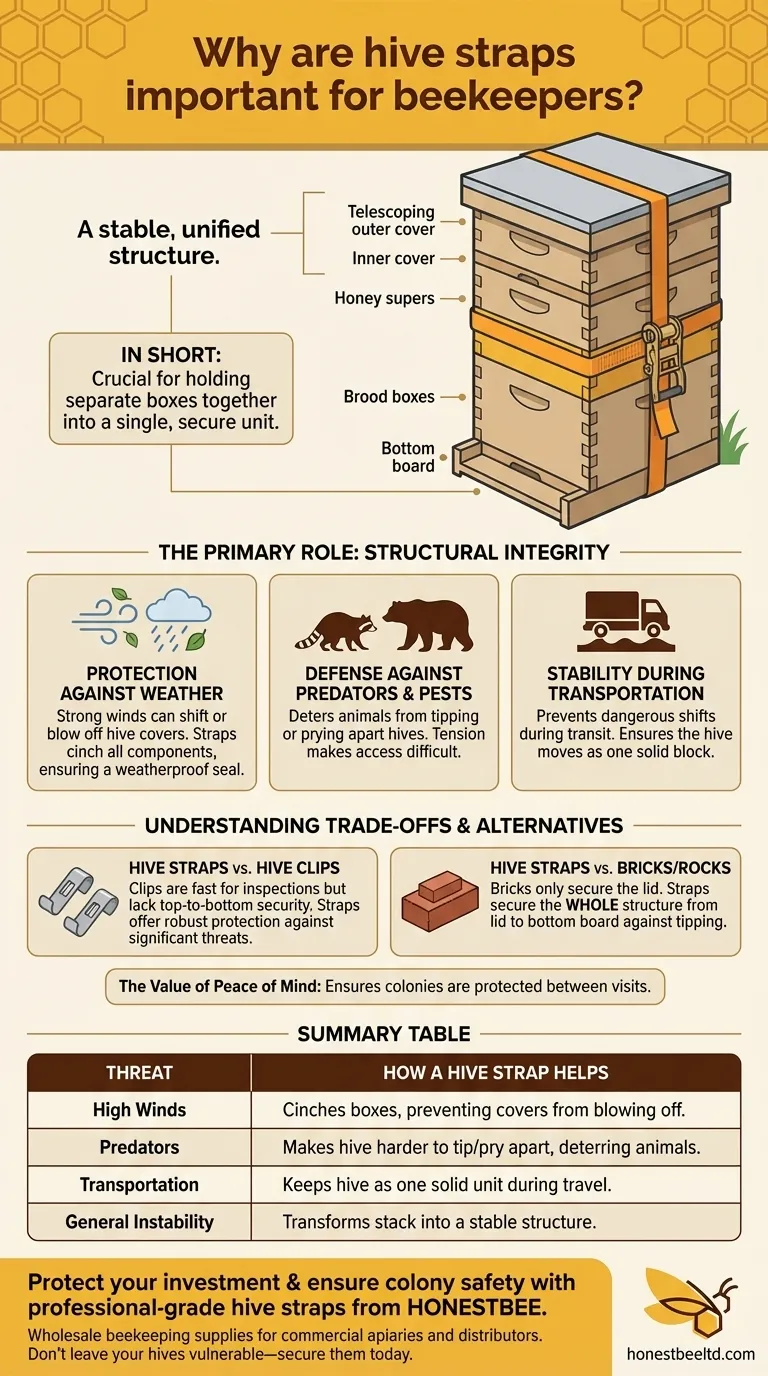In short, hive straps are crucial for holding the separate boxes of a beehive together into a single, secure unit. This simple tool is a beekeeper's best defense against external threats like high winds, tipping by animals, or shifting during transportation, providing essential peace of mind that the colony's home will remain intact.
A beehive is a vertical stack of boxes, and its weakest points are the seams between those boxes. A hive strap transforms this vulnerable stack into a stable, unified structure, offering a powerful and inexpensive form of insurance against disaster.

The Primary Role of Hive Straps: Structural Integrity
A modern beehive consists of multiple components: a bottom board, brood boxes, honey supers, an inner cover, and a telescoping outer cover. While heavy, this stack can be surprisingly fragile when faced with external force.
Protection Against Weather
High winds are a common and serious threat to beehives. A strong gust can easily shift or even blow the top cover or honey supers off a hive, exposing the colony to rain, cold, and pests.
A securely fastened hive strap cinches all these components together, ensuring the hive remains sealed and weatherproof even during a storm.
Defense Against Predators and Pests
Larger animals like raccoons, bears, or even curious livestock can knock over hives in search of honey and brood. Once a hive is toppled, the colony is highly vulnerable and may not survive.
While a strap may not stop a determined bear, it is an effective deterrent against many animals. The tension makes it significantly harder to tip the hive or pry the boxes apart, often encouraging the animal to move on.
Stability During Transportation
For beekeepers who need to move their colonies to new locations for pollination or better nectar flow, hive straps are non-negotiable.
The bumps and vibrations of travel can easily cause hive bodies to shift and separate, potentially allowing bees to escape inside the vehicle. A ratchet strap ensures the entire hive moves as one solid block, keeping it secure and the bees safely contained.
Understanding the Trade-offs and Alternatives
While straps are a standard security measure, it's useful to understand how they compare to other methods. Each has a distinct purpose.
Hive Straps vs. Hive Clips
Hive clips or fasteners are small metal clamps used to connect individual boxes. They are very fast to apply and remove, making them convenient for beekeepers who perform frequent inspections.
However, they do not provide the same level of comprehensive, top-to-bottom security as a strap. Clips are best for convenience in low-risk environments, while straps are essential for robust protection against significant threats.
Hive Straps vs. Bricks or Rocks
Many beekeepers place a heavy rock or brick on the hive lid to prevent it from blowing off. This is a simple and common practice, but it only secures the lid itself.
This method offers no protection against the entire hive being tipped over by an animal or stronger winds. A hive strap secures the whole structure, from the lid down to the bottom board.
The Value of Peace of Mind
The references correctly highlight "reassurance" as a key benefit. For beekeepers with many hives or apiaries located far from home, daily checks are impossible.
A hive strap ensures you have taken the single most effective step to physically protect the colony's home until your next visit.
Making the Right Choice for Your Goal
Using a hive strap is a simple action that addresses a fundamental risk in beekeeping. Your specific situation determines the type and urgency.
- If your primary focus is moving hives: Heavy-duty ratchet straps are absolutely essential for safe and secure transportation.
- If your primary focus is protecting against high winds or animals: A strong cambuckle or ratchet strap is a critical piece of equipment for every hive in your apiary.
- If your primary focus is convenience during frequent inspections in a secure yard: Simple hive clips may suffice, but a strap is always a recommended backup for storm season.
Ultimately, a hive strap is one of the most cost-effective investments you can make for the safety and security of your bees.
Summary Table:
| Threat | How a Hive Straps Helps |
|---|---|
| High Winds | Cinches boxes together, preventing covers and supers from blowing off. |
| Predators (Raccoons, Bears) | Makes hive harder to tip or pry apart, deterring animals. |
| Transportation | Keeps hive as one solid unit during travel, preventing dangerous shifts. |
| General Instability | Transforms a stack of boxes into a single, stable structure. |
Protect your investment and ensure your colonies' safety with professional-grade hive straps from HONESTBEE. We supply durable, reliable beekeeping supplies and equipment to commercial apiaries and beekeeping equipment distributors through our wholesale-focused operations. Don't leave your hives vulnerable—contact our experts today to secure your apiary with the right equipment for your specific needs.
Visual Guide

Related Products
- Professional Galvanized Hive Strap with Secure Locking Buckle for Beekeeping
- Professional Engraved Round Hive Number Tags for Beekeeping
- Wholesales Dadant Size Wooden Bee Hives for Beekeeping
- Reusable Clear Small Hive Beetle Traps for Beehives Beetle Trapping Tools
- Black Plastic Beetle Barn Hive Beetle Trap for Beehives
People Also Ask
- What maintenance is required for hive straps? A Guide to Cam Buckle vs. Ratchet Strap Care
- What is the advantage of using cam buckle straps? Secure Your Load Fast with Simple, Safe Tensioning
- What are the types of Emlocks available? Choose the Right Strap for Hive Security
- What are hive straps and why are they used? Secure Your Hives Against Wind, Predators, and Transport
- What is the best length for straps used around beehives? Why 12 Feet is the Industry Standard



















